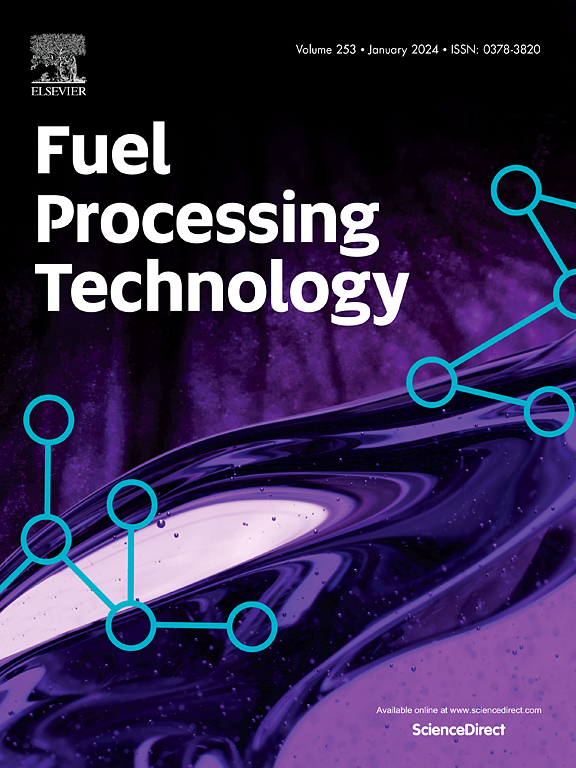双金属Ni-Mo₂C催化剂中Ni-Mo比的系统优化,用于乙酰丙酸高效选择性加氢制备γ-戊内酯
IF 7.7
2区 工程技术
Q1 CHEMISTRY, APPLIED
引用次数: 0
摘要
本文采用共浸渍法,系统地研究了协同双金属Ni-Mo₂C催化剂中Ni-Mo比的优化,然后通过碳热还原过程将煅烧的前驱体转化为碳化物结构。对乙酰丙酸(LA)加氢制γ-戊内酯(GVL)的催化性能进行了评价。进行了全面的物理和结构表征,以阐明构效关系。在所设计的NixMoyC催化剂中,Ni1.0Mo1.0C催化剂的Ni / Mo比为1.0:1.0时,LA加氢成GVL的活性最高。Ni1.0Mo1.0C催化剂的优异性能归因于金属Ni0和Mo2C之间的协同界面电子相互作用,以及有序碳层结构的存在。在优化的反应条件下(160℃,20 bar H₂压力,8 H反应时间,20 wt%催化剂负载),Ni1.0Mo1.0C催化剂实现了完全的LA转化,GVL收率为97.4%。这种高性能归因于它的小颗粒尺寸,提高H2吸附-解吸能力,以及存在适当分布的酸性位点。这些发现突出了Ni-Mo₂C催化剂在从LA高效生产GVL方面的竞争力,在可持续生物炼制过程中提供了有前景的应用。本文章由计算机程序翻译,如有差异,请以英文原文为准。

Systematic optimization of the Ni-to-Mo ratio in bimetallic Ni–Mo₂C catalysts for efficient selective hydrogenation of levulinic acid to γ-valerolactone
In this investigation, the optimization of Ni-to-Mo ratios in synergistic bimetallic Ni–Mo₂C catalysts was systematically investigated through a co-impregnation method, followed by the transformation of the calcined precursors into carbide structures via a carbothermal reduction process. The catalytic performance was evaluated for the hydrogenation of levulinic acid (LA) to γ-valerolactone (GVL). Comprehensive physical and structural characterizations were carried out to elucidate the structure–activity relationships. In the designed NixMoyC catalysts, a Ni to Mo ratio of 1.0: 1.0, corresponding to the Ni1.0Mo1.0C catalyst, exhibited the highest activity for hydrogenating LA into GVL. The superior performance of the Ni1.0Mo1.0C catalyst is attributed to the synergistic interfacial electronic interactions between the metallic Ni0 and Mo2C species, along with the presence of well-ordered carbon layer structures. Under optimized reaction conditions (160 °C, 20 bar H₂ pressure, 8 h reaction time, and 20 wt% catalyst loading), the Ni1.0Mo1.0C catalyst achieved complete LA conversion and a GVL yield of 97.4 %. This high performance is attributed to its small particle size, improved H2 adsorption–desorption capacity, and the presence of appropriately distributed acidic sites. These findings highlight the competitive performance of Ni–Mo₂C catalysts for the efficient production of GVL from LA, offering promising applications in sustainable biorefinery processes.
求助全文
通过发布文献求助,成功后即可免费获取论文全文。
去求助
来源期刊

Fuel Processing Technology
工程技术-工程:化工
CiteScore
13.20
自引率
9.30%
发文量
398
审稿时长
26 days
期刊介绍:
Fuel Processing Technology (FPT) deals with the scientific and technological aspects of converting fossil and renewable resources to clean fuels, value-added chemicals, fuel-related advanced carbon materials and by-products. In addition to the traditional non-nuclear fossil fuels, biomass and wastes, papers on the integration of renewables such as solar and wind energy and energy storage into the fuel processing processes, as well as papers on the production and conversion of non-carbon-containing fuels such as hydrogen and ammonia, are also welcome. While chemical conversion is emphasized, papers on advanced physical conversion processes are also considered for publication in FPT. Papers on the fundamental aspects of fuel structure and properties will also be considered.
 求助内容:
求助内容: 应助结果提醒方式:
应助结果提醒方式:


